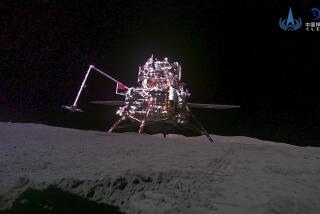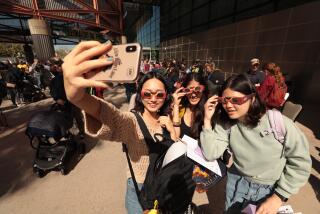Finding lost moon rocks is his mission
Reporting from Houston — Alaska’s moon rocks disappeared on Sept. 6, 1973.
A fire set by an arsonist had torn through the state transportation museum in Anchorage, where the four rocks had been on display.
The fragments, each smaller than a pea, were among 48 pounds of lunar material retrieved four years earlier by astronauts aboard Apollo 11. President Nixon gave samples to each state to celebrate man’s first walk on the moon.
The Alaska museum curator’s stepson, 17-year-old Arthur Coleman Anderson, sneaked inside the disaster scene to poke through the debris. He came across a Lucite ball mounted on a walnut plaque featuring the state flag. Inside the ball were four rocks.
Anderson figured the plaque, once cleaned up and polished, would make a neat souvenir. And so, as clean-up crews set about their work, he walked away with a national treasure.
It would be nearly 37 years before he attracted the attention of the moon rock hunter.
*
“I hate incompetence,” Joseph Gutheinz said. He was in his Houston-area law office, seated at a desk adorned with a silver-and-black globe labeled “moon rock hunter.”
It irks Gutheinz, an Army veteran, retired NASA investigator and the son of Camp Pendleton Marines, that authorities have allowed hundreds of lunar rocks to disappear or fall into the hands of businessmen, dictators and thieves.
It is illegal for individuals, even astronauts, to own moon rocks. The U.S. distributed samples to states and nations as signs of goodwill — symbols of extraordinary human achievement intended to be displayed — and many of them are unaccounted-for.
Hundreds of rocks that NASA loaned to researchers have also been lost or stolen over the years, the space agency’s inspector-general reported in December.
“To me, NASA’s missions to the moon have been a tribute to the best of mankind, and NASA’s handling of the moon rocks recovered by our astronauts has been lacking,” Gutheinz said.
NASA has promised to tighten its inventory controls, and officials note that the lost research samples represent a tiny fraction of the moon detritus in the agency’s vaults. But NASA isn’t responsible for the rocks given away to states and foreign governments, and it’s those bits of lunar debris that have consumed Gutheinz’s attention for years.
He wants to know where they are, and he wants to bring them home.
Gutheinz, 56, is not the only one for whom the lunar mementos retain a special allure. At the Smithsonian National Air and Space Museum in Washington, tourists wait in long lines to touch a moon rock on display under guard.
The end of moon missions and cutbacks to the space program have increased their value on the black market to millions of dollars apiece.
Gutheinz followed the Apollo missions as a teenager, and came to admire NASA as “the best that America had to offer.” He worked his way up from military aviator and intelligence officer to special agent for the Federal Aviation Administration, later the Department of Transportation and finally NASA. Along the way, he obtained a law degree.
At the space agency, he investigated matters ranging from problems with the space shuttles to astronaut impersonators and fraudulent contractors. He appeared an unlikely G-man: short and affable, with a thick black beard. The combination helped him stage successful stings, including his most famous effort, Operation Lunar Eclipse.
The year was 1998. Posing as a dealer in rare space debris named Tony Coriasso (a name borrowed from his uncle) he created a dummy company, John’s Estate Sales, intending to snare people peddling fake moon stones.
As bait, he took out a quarter-page ad in USA Today, illustrated with an astronaut walking on the moon, that proclaimed: “Moon rocks wanted.”
It didn’t take long for someone to bite.
A dealer arranged to meet Gutheinz at a waterfront restaurant in Miami Beach. He showed him a photograph of a Lucite ball affixed to a plaque with a flag. Gutheinz was surprised: The rock inside the Lucite ball appeared to be genuine, one recovered by the Apollo 17 astronauts in 1972.
Gutheinz agreed to buy the lunar lump for $5 million cash.
The dealer offered to bring the rock to a Bank of America vault in Miami so a bank officer could photograph them. When he showed up, the bank official — actually an undercover U.S. customs agent — seized the rock.
It turned out the rock was a gift to the Republic of Honduras that had disappeared from the presidential palace. The dealer claimed a Honduran military officer had sold it to him for $50,000.
Gutheinz realized NASA could not possibly keep track of the 270 moon rocks presented to foreign countries and more than 100 given to states.
And so the hunt began. Often relying on paper trails and interviews, Gutheinz located a few missing samples, such as an Apollo 17 moon rock given to Cyprus that had fallen into the hands of a diplomat’s son. The chase heated up in 2002, two years after Gutheinz retired from NASA and began pursuing moon rocks as a pastime.
Gutheinz was teaching criminal justice at Alvin Community College near Houston and online through the University of Phoenix. As an investigative exercise, he challenged his students to find a moon rock.
“I never expected it to go past the first class,” he said.
But it did. So far, Gutheinz and his students have tracked down 77 moon rocks.
Among them:
•California’s, which turned up in storage at the San Diego Air and Space Museum. (“They forgot they even had it,” Gutheinz said.)
• West Virginia’s, found at the home of a retired dentist who had received it from associates of former Gov. Arch A. Moore Jr.
•Arkansas’, which surfaced in President Clinton’s files from his days as governor.
•Colorado’s, which former Gov. John Vanderhoof acknowledged he still had. He returned the rock to the Colorado School of Mines Geology Museum for display.
*
Three years ago, Gutheinz assigned one of his students to find out what happened to Alaska’s Apollo 11 moon rocks. The student could find no sign of them and wrote about her search in a Juneau newspaper.
Afterward, Alaska officials received a request from a Seattle lawyer for the state’s records on the 1973 museum fire. A few months later, the lawyer surprised them by revealing that the rocks were in the possession of Arthur Coleman Anderson, the museum curator’s stepson.
Anderson sued the state, arguing that the court should declare him the rightful owner of the Apollo 11 memento. State officials had abandoned the rocks in the ashes all those years ago, the suit maintained, whereas Anderson had restored and cared for them over the years.
Anderson, who had gained fame as a fishing captain featured on the Discovery Channel series “Deadliest Catch,” said through his lawyer that if Alaska officials wanted the plaque back, they would have to buy it, although he did not suggest a price.
In September, a judge ordered Anderson to produce the moon rocks within a month so they could be authenticated. He has yet to do so.
Anderson, who now lives in Corpus Christi, Texas, did not return calls seeking comment. The case is set for trial early next year.
Gutheinz said he’s almost persuaded by Anderson’s line of reasoning.
“From an attorney’s point of view, I enjoyed it,” Gutheinz said. “From a NASA point of view, I didn’t.”
So the hunt continues. Gutheinz dreams of traveling to Europe to pursue lunar samples whose fate is unknown. Romania is high on his list. After dictator Nicolae Ceausescu was toppled in 1989, the country’s Apollo 17 moon rock vanished.
“My long-term goal is to go out there and talk to the former head of the Communist Party and find out if he has any idea where that moon rock might be,” he said.
There’s also the Emerald Isle. “I’d like to go take a look at the dump in Ireland for the moon rock that was thrown away after a fire,” he said.
Based on his students’ research, Gutheinz says that “most of the nations in Africa are missing their moon rocks.”
Among those missing are samples given to the late Libyan dictator Moammar Kadafi.
“Good luck trying to find those.”
More to Read
Sign up for Essential California
The most important California stories and recommendations in your inbox every morning.
You may occasionally receive promotional content from the Los Angeles Times.











